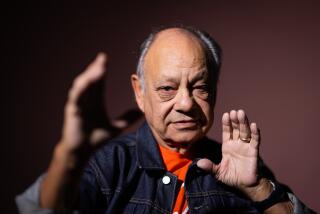Missions Possible
The exhibit at the Ventura County Museum of History and Art casts its gaze across the centuries and across the street, to fascinating effect. In its main exhibition, âMissions of California: The Etchings of Henry Chapman Ford,â and other ancillary displays, the subject at the museum is Californiaâs pioneering mission system, including the San Buenaventura Mission, which can be seen just across Main Street.
In a very real way, the current exhibitions--which include a showing of artifacts lent from the local missionâs archives for the occasion--represent a rare collaboration between the institutions. On view are colorful, well-preserved vestments, a thurible (incense burner), missal (prayer book) stand and an original tabernacle from the mission, which was founded by Father Junipero Serra in 1782.
In the artifact area of the gallery, we even find a reunion, of an 18th-century monstrance--a receptacle to hold consecrated wafers and part of the museumâs collection--and the monstranceâs case, on loan from the mission.
At the center of all this activity are Fordâs etchings, a recent and important gift to the museum. The 24 etchings were done in 1883, a time when the mission system was in a state of disrepair. Fordâs art, among other forms of activist and preservationist energy, helped to nurture a mission restoration campaign.
Raised in New York, Ford was an itinerant sort who spent time in Europe, even after settling down in Santa Barbara in 1875. His interest in the missions probably related in some way to a Europhileâs love of antique lore, since a 200-year-old building qualifies as ancient in these parts.
One peripheral charm of these images is the vision of a rustic, unpopulated California. Although we know otherwise, missions are seen as idyllic bastions of order and meditation on sparse, beautiful landscapes, long before the incursion of urban sprawl or suburban creep.
In an 1875 photo, we see the artist himself, perched amid the cacti behind the San Buenaventura Mission. An etching of Venturaâs mission depicts the unspoiled structure, with a cross on the hill behind it and without interference from neighboring secular structures which, by then, were cropping up in the young city. Ford gives handsome artistic validity to the local mission, as he does to other missions, in contrast to an anonymous, humble pen sketch of the mission circa 1835.
In Fordâs admiring view, Santa Barbaraâs famed edifice looms over its hillside roost, with no other structures or roads in sight, and San Gabrielâs mission stands tall and stately, as if proudly brandishing its formidable facade. Two intriguing images present altering views of the Carmel Mission, one with oxen lazing about the acreage and another from a long view, a tree in the foreground and the Pacific Ocean beyond. Itâs a picture of idyllic beauty.
Not all the missions, of course, were so pristine. Certainly decay and disuse had befallen La Soledad, La Purisima--since impressively restored and rebuilt--and San Juan Capistrano.
Over in the museumâs hallway, there is a latter-day complement to Fordâs series. Lompoc-based artist Leonardo Y. Nunez shows his series of mission etchings, done in 1997. These are close-up, finely rendered views of the architecture, and in some way they validate the success of Fordâs work a hundred years hence. Many of the missions have been restored and placed in proper historical trust.
The subplot here is that, in a culture obsessed with youth and trend-setting, an appreciation of local antiquities can give us Californians a sense of rootedness. At least, it puts our localized sense of time, culture and history in a broader perspective.
To boot, this work makes us want to load up the Winnebago to go on a mission-hopping adventure of our own.
DETAILS
âMissions of California: The Etchings of Henry Chapman Ford,â through June 3 at the Ventura County Museum of History and Art, 100 E. Main St. in Ventura. Gallery hours: 10 a.m.-5 p.m. Tuesday-Sunday; 653-0323.
*
Josef Woodard, who writes about art and music, can be reached by e-mail at [email protected].
More to Read
The biggest entertainment stories
Get our big stories about Hollywood, film, television, music, arts, culture and more right in your inbox as soon as they publish.
You may occasionally receive promotional content from the Los Angeles Times.










